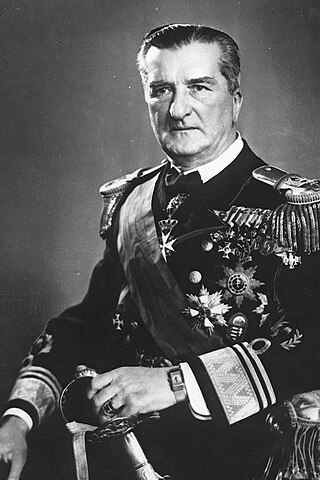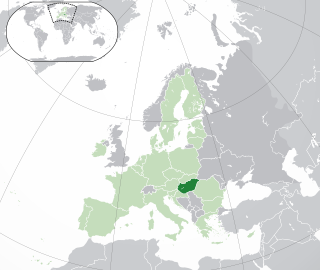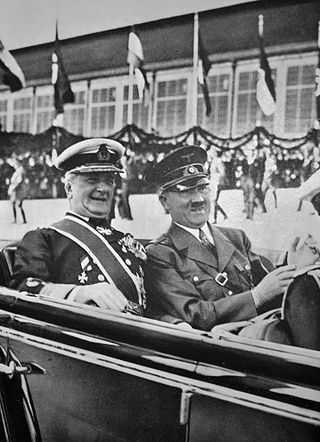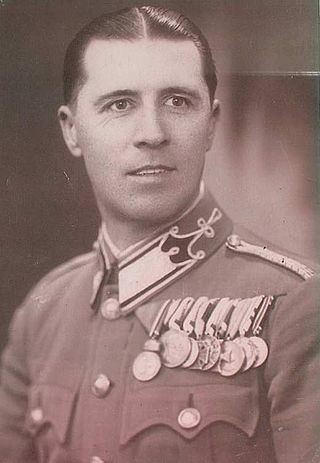
Miklós Horthy de Nagybánya, was a Hungarian admiral and statesman who served as the regent of the Kingdom of Hungary during the interwar period and most of World War II – from 1 March 1920 to 15 October 1944.

Raoul Gustaf Wallenberg was a Swedish architect, businessman, diplomat, and humanitarian. He saved thousands of Jews in German-occupied Hungary during the Holocaust from German Nazis and Hungarian fascists during the later stages of World War II. While serving as Sweden's special envoy in Budapest between July and December 1944, Wallenberg issued protective passports and sheltered Jews in buildings which he declared as Swedish territory.

Giorgio Perlasca was an Italian businessman and former Fascist who, with the collaboration of official diplomats, posed as the Spanish consul-general to Hungary in the winter of 1944, and saved 5,218 Jews from deportation to Nazi extermination camps in eastern Europe. In 1989, Perlasca was designated by Israel as a Righteous Among the Nations.

The Arrow Cross Party was a far-right Hungarian ultranationalist party led by Ferenc Szálasi, which formed a government in Hungary they named the Government of National Unity. They were in power from 15 October 1944 to 28 March 1945. During its short rule, ten to fifteen thousand civilians were murdered outright, including many Jews and Romani, and 80,000 people were deported from Hungary to concentration camps in Austria. After the war, Szálasi and other Arrow Cross leaders were tried as war criminals by Hungarian courts.
The Budapest Ghetto was a Nazi ghetto set up in Budapest, Hungary, where Jews were forced to relocate by a decree of the Government of National Unity led by the fascist Arrow Cross Party during the final stages of World War II. The ghetto existed from November 29, 1944, to January 17, 1945.

The history of the Jews in Hungary dates back to at least the Kingdom of Hungary, with some records even predating the Hungarian conquest of the Carpathian Basin in 895 CE by over 600 years. Written sources prove that Jewish communities lived in the medieval Kingdom of Hungary and it is even assumed that several sections of the heterogeneous Hungarian tribes practiced Judaism. Jewish officials served the king during the early 13th century reign of Andrew II. From the second part of the 13th century, the general religious tolerance decreased and Hungary's policies became similar to the treatment of the Jewish population in Western Europe.

The Dohány Street Synagogue, also known as the Great Synagogue or Tabakgasse Synagogue, is a historical building on Dohány Street in Erzsébetváros, the 7th district of Budapest, Hungary. It is the largest synagogue in Europe, seating 3,000 people and is a centre of Neolog Judaism.

The Shoes on the Danube Bank is a memorial erected on 16 April 2005, in Budapest, Hungary. Conceived by film director Can Togay, he created it on the east bank of the Danube River with sculptor Gyula Pauer to honour the Jews who were massacred by fascist Hungarian militia belonging to the Arrow Cross Party in Budapest during the Second World War. They were ordered to take off their shoes, and were shot at the edge of the water so that their bodies fell into the river and were carried away. The memorial represents their shoes left behind on the bank.

Pál Szalai also spelled Pál Szalay and later anglicized as Paul Sterling was a high-ranking Hungarian police officer and disillusioned member of the Arrow Cross Party. In 1945, together with Swedish diplomat Raoul Wallenberg, Szalai helped save hundreds of Hungarian Jews in the Budapest ghetto.

During World War II, the Kingdom of Hungary was a member of the Axis powers. In the 1930s, the Kingdom of Hungary relied on increased trade with Fascist Italy and Nazi Germany to pull itself out of the Great Depression. Hungarian politics and foreign policy had become more stridently nationalistic by 1938, and Hungary adopted an irredentist policy similar to Germany's, attempting to incorporate ethnic Hungarian areas in neighboring countries into Hungary. Hungary benefited territorially from its relationship with the Axis. Settlements were negotiated regarding territorial disputes with the Czechoslovak Republic, the Slovak Republic, and the Kingdom of Romania. On November 20, 1940, Hungary became the fourth member to join the Axis powers when it signed the Tripartite Pact. The following year, Hungarian forces participated in the invasion of Yugoslavia and the invasion of the Soviet Union. Their participation was noted by German observers for its particular cruelty, with occupied peoples subjected to arbitrary violence. Hungarian volunteers were sometimes referred to as engaging in "murder tourism."

Angelo Rotta was an Italian prelate of the Catholic Church. As the Apostolic Nuncio in Budapest at the end of World War II, he was involved in the rescue of the Jews of Budapest from the Nazi Holocaust. He is a significant figure in Catholic resistance to Nazism.

László Endre was a Hungarian right-wing politician and collaborator with the Nazis during the Second World War.

The city of Budapest was officially created on 17 November 1873 from a merger of the three neighboring cities of Pest, Buda and Óbuda. Smaller towns on the outskirts of the original city were amalgamated into Greater Budapest in 1950. The origins of Budapest can be traced to Celts who occupied the plains of Hungary in the 4th century BC. The area was later conquered by the Roman Empire, which established the fortress and town of Aquincum on the site of today's Budapest around AD 100. The Romans were expelled in the 5th century by the Huns, who were challenged by various tribes during the next several centuries. The Hungarian conquest of the Carpathian Basin started at the end of the 9th century, and the Kingdom of Hungary was established at the end of the 11th century.

Perlasca – Un eroe Italiano is a 2002 Italian drama, directed by Alberto Negrin, about Giorgio Perlasca, an Italian businessman working in Hungary for his government. After the surrender of Italy to the Allies, he took refuge in the Spanish embassy. Aware of the threat to Jews, he first began to help them find shelter in Spanish safe houses.

The Order of Vitéz is a Hungarian order of merit which was founded in 1920. It was awarded as a state honour from 1920 to 1944, and continues as a semi-independent order of chivalry under Captain General vitéz József Károly von Habsburg, head of the Palatinal branch of the House of Habsburg.

El ángel de Budapest is a Spanish 2011 World War II-Holocaust television film based on the book Un español frente al Holocausto written by journalist and radio executive director Diego Carcedo. The executive producers are José Manuel Lorenzo, Eduardo Campoy and István Major, the first two had collaborated on the spiritual film Sin noticias de Dios (2001). The film was shot between 9 November 2010 and 23 December 2010 in Budapest, Hungary.

Walking with the Enemy is a 2014 American action drama film directed by Mark Schmidt, and scripted by Kenny Golde and Mark Schmidt. The film stars Jonas Armstrong, Ben Kingsley, Simon Kunz, Hannah Tointon, Simon Dutton, Burn Gorman, and Charles Hubbell. It is inspired by the true story of Pinchas Tibor Rosenbaum.

The Holocaust in Hungary was the dispossession, deportation, and systematic murder of more than half of the Hungarian Jews, primarily after the German occupation of Hungary in March 1944.

Tibor Baranski was a Hungarian-American man credited with saving more than 3,000 Hungarian Jewish women, men and children from the Nazis during the Holocaust.

László Ferenczy was a lieutenant colonel in the Hungarian Royal Gendarmerie and member of its "central dejewification unit" during World War II and the Holocaust.



















